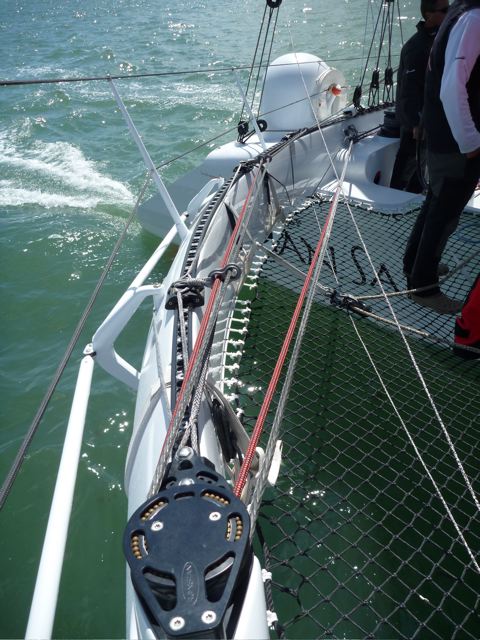Light winds are no obstacle to this 105ft ocean sprinter
There was a shortage of wind in the Solent today but it doesn’t take much for Oman Sail’s 105ft trimaran Majan to speed along. I had to be wrestled off the helm today as we sprinted out to the western Solent, speeding past assorted regatta yachts as if they were in a slow lane.
The trimaran, a stretched version of Ellen MacArthur’s record-breaking tri B&Q, is being primed for the solo Route du Rhum race in November. The skipper will be French sailor Sidney Gavignet and today was a corporate day out to showcase the boat and introduce the skipper.
These giant multis are back in the Route du Rhum; after years of exclusion there is a no-limits class. Majan will be racing against the likes of Francis Joyon’s trimaran IDEC, Thomas Coville’s Sodeb’O (similar, also 105ft with the performance enhancing features of a canting rig and curved foils), and the revamped Gitana 11, an ORMA 60 turned 77-footer.
The power of these big trimarans is something to experience. In 9 knots of breeze we were powering along at 13-15 knots. Weirder still is the experience of being pretty hard on the wind with an apparent wind angle of 45° and the displays showing a true wind angle of 120°.
The trimaran has twin carbon wheels as she is designed to be sailed crewed or solo. The helm is deliciously light but also quite neutral as she is designed to be sailed under autopilot when shorthanded.
Majan is the first of a hoped for class, the A100 (although actually 105ft overall).
Here are some interesting shots of the boat.
This one shows the cockpit layout. It is sheltered somewhat by the extended coachroof of the cabin.

The aft beam on which the main sheet and traveller are fitted is semi-circular. This photo shows the mainsheet purchase and traveller lines.

This photo shows the mast foot ball, on which the mast rotates. A lot of compression load on a little area.

Below is the port cap shroud – interesting because like some of the latest racing yachts there is no lashing to fit it in place. The project manager and usual skipper of Majan, Whitbread and Volvo Race veteran Paul Standbridge tells me that the shroud, which is made of PBO by Futures Fibres, is wound to the exact, precise loaded measurement from the top of mast to each hull and bolted in place.
The shrouds are fitted first, he tells me, then the gennaker halyard is wound up so that the fixed forestay can be fitted. This highly precise way of rigging the boat means that whenever the boat is de-rigged and the mast stepped again the crew can be sure that the rig is exactly centred; there are no tuning adjustments to be made.





